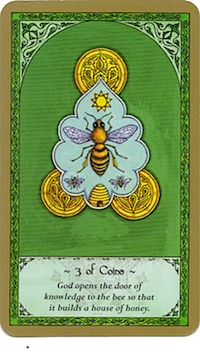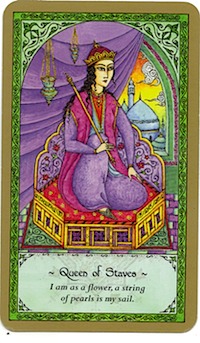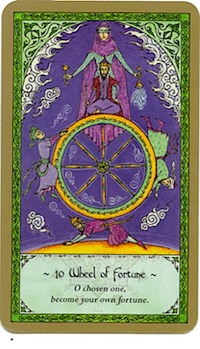By Andrew Harris
Rumi Tarot, authored and illustrated by Nigel Jackson
Llewellyn Publications, May 2009
ISBN # 978-0-7387-1168-3
I was immediately attracted to Nigel Jackson’s Rumi Tarot (Llewellyn Publications, 2009) for its beautiful artwork and vibrant colors, predominantly on the cool side of the spectrum, mostly green and blue. I have paid passing attention to Rumi in recent years, and though I can't claim familiarity, I have certainly been impressed, enough that my expectations for a Rumi-inspired Tarot were pretty high. I was pleased to find that Nigel Jackson's work inspired and educated me, and didn't disappoint at all. Like a rose just beginning to unfold, it makes me feel welcome and gives a hint of the complexities I’ll encounter should I look deeper and spend more time with it, while the fragrance is quickly turning attraction for this Tarot into love.
I first turned to the book to catch up on Rumi and was treated to a concise introduction to Sufis and their beliefs. Illustrative examples from Rumi and other prominent Sufis, information about the development of this esoteric type of Islam historically (with emphasis on the influence from gnosticism and impact on Islamic and other traditions), and a biography of Rumi is included at the start of the book. This part taught me a lot quickly, and made me comfortable with the context of the Tarot. I'm sure it would do the same for anyone with no knowledge of Rumi, but it would also be insightful for those in the know. Jackson reveals how appropriate it is for a Tarot to be based on Rumi and Sufi beliefs, and in the final section of this part of the book, he gives a history of Tarot cards that traces their roots to Saracen cards from the east and then back to Chinese cards, themselves developed from Korean shamanic divination using arrows and silk.
While there is not a suggestion of Sufis using cards for divination, they do use card symbology for expressing themselves about the divine, and for centuries, they even used one of Rumi’s books as an oracle. Sufi beliefs (man is a microcosm of the universe, all things are part of and reflect divinity, losing the ego allows union with the supreme, love) are a perfect match for the Tarot, and the Rumi Tarot is a beautiful way to discover, remember, and awaken them.
The book also offers a complete guide to the Tarot’s divinatory meanings, and also associates one of the 99 names of God with each card.
The cards are average size, four-and-a-half by two-and-three-quarter inches. They are fairly slick but with a little resistance when they slide. They are very easy to shuffle; they seem to just fly together. The backs are green with a blue-and-green snowflake-star with a floral look in the middle. The fronts all have a solid gold border, then a thin green border with serifs along it surrounding each image. The art is beautiful. The suit cards—Cups, Coins, Staves, and Swords—have golden elements for each suit on green backgrounds, and each also has a picture inset in a peaked flower-shaped window with lots of detail and color. There are many human figures here and quite a few animals. The people on the court cards (king, queen, knight, and page) are the full size of the cards with their own backgrounds. Most of the Trump cards are full figures as well, although in some the figures are smaller. The basic positioning of the Trump figures and elements looks familiar with other Tarots, but everything is Arabic from costume to architecture, and the elements all have meaning within Sufi tradition or within Rumi's work. These can be explored with the help of the other sections of the book which describe the symbols and explain their meanings. Each card also has a phrase at the bottom, a verse from Rumi: the Chariot says, "Journey forth from your own self to God's Self," the King of Staves reads, "Rejoice in the pleasant things and the success of the objects," the Tower says, "From this minaret, hundreds of thousands of people like Ad fell," and the Three of Cups contains the verse, "God mingled in the dusty earth a draught of beauty from his choicest cup."
I would highly recommend this Tarot to anyone for its beauty and for the calm and peace that comes with handling it, but especially for people interested in Rumi. For those like me who are curious, it is a great foundation and tool for learning. For those further along, it would be a sweet way to remember and a shining help on your journey, like postcards from your dear friend.


